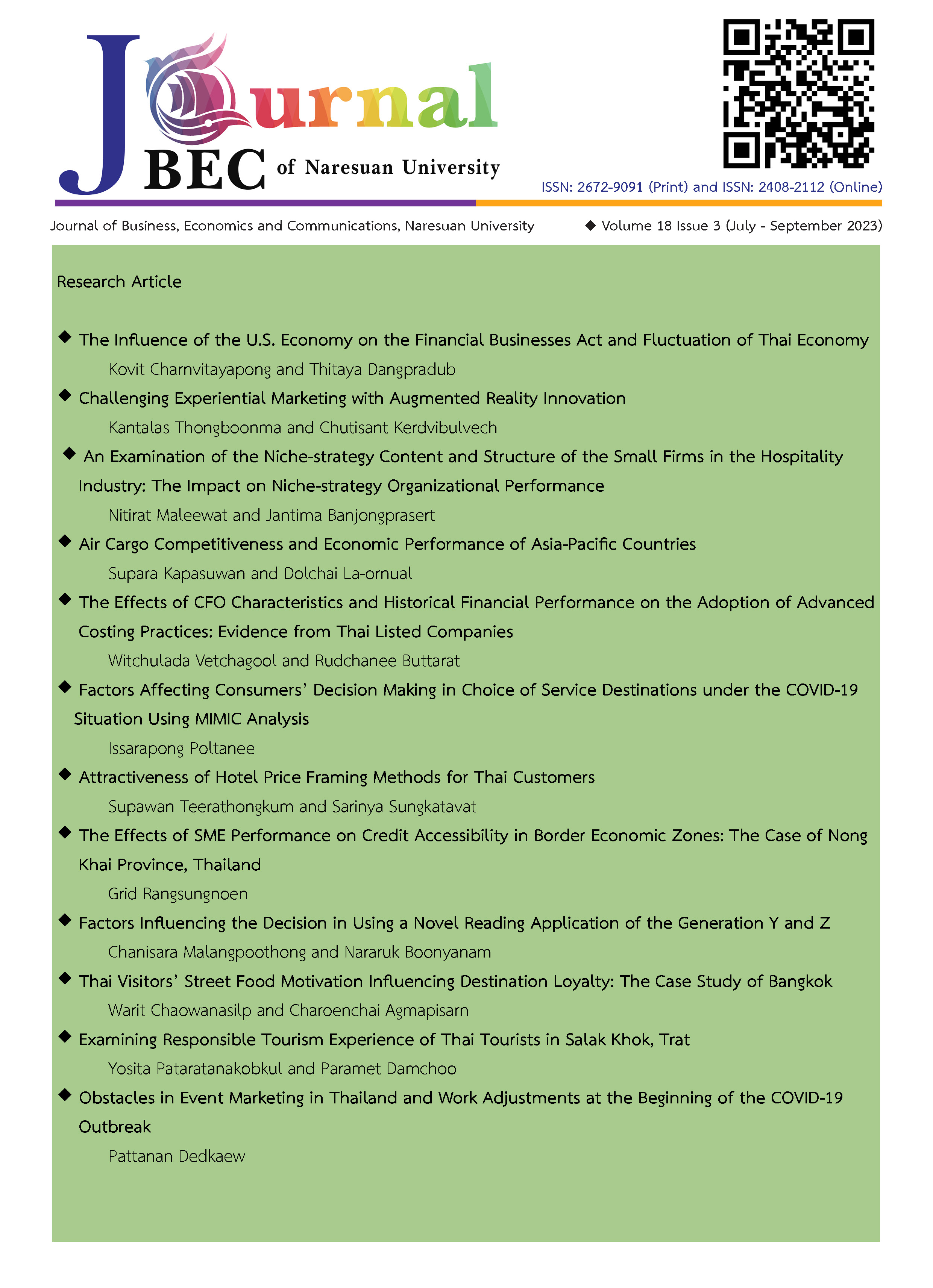The Influence of the U.S. Economy on the Financial Businesses Act and Fluctuation of Thai Economy
Main Article Content
บทคัดย่อ
The purpose of this study is to examine whether the financial rules and regulations, economic policies, and international agreements of the U.S. could be the source of banking, financial business laws, and economic fluctuations in small-opened economies, one of which is Thailand. This study used documentary research and inductive reasoning to examine the origins of the U.S. Great Depression in 1929 and the other three global economic crises: the Latin, Asian, and subprime crises. The findings seemed to support the notion that U.S. financial laws, rules, regulations, economic policies, economic problems, international agreements, and policy remedies may cause economic fluctuations in countries with small-opened economies. To avoid these economic fluctuations, small-open-economy countries should defend themselves when signing international agreements. They should make use of reservation clauses in the international agreement. The final proposal is that small-open economies, such as Asian countries, should form an institution with the same function as the IMF to maintain the group's financial stability.
Article Details

อนุญาตภายใต้เงื่อนไข Creative Commons Attribution-NonCommercial-NoDerivatives 4.0 International License.
เอกสารอ้างอิง
Ahmed, S., Akinci, O. and Queralto, A. (2021). U.S. monetary policy spillovers to emerging markets: both shocks and vulnerabilities matter. Retrieved March 22, 2022, from https://doi.org/10.17016/IFDP.2021.1321
Aiginger, K. (2010). The great recession versus the great depression: Stylized facts on siblings that were given different foster parents. Retrieved March 25, 2022, from https://www.econstor.eu/handle/10419/32773
Klingelbiel, D., Hernandez, L. and Alba, P. (1999). Financial liberalization and the capital account: Thailand 1988-97. Retrieved March 22, 2022, from https://elibrary.worldbank.org/doi/epdf/10.1596/1813-9450-2188
Arora, V. and Vamvakidis, A. (2006). The impact of U.S. economic growth on the rest of the world: How much does it matter?. Journal of Economic Integration, 21(1), 21-39.
Berger, A. N., Kashyap, A. K. and Scalise, J. M. (1995). The transformation of the U.S. banking industry: what a long, strange trip it’s been. Brookings Papers on Economic Activity, 1995(2), 55–218.
Bowman, D., Londono, J. M. and Sapriza, H. (2015). U.S. Unconventional monetary policy and transmission to emerging market economies. Journal of International Money and Finance, 55, 27-59.
Charnvitayapong, K. (2018). Monetary theory and policy (2nd ed.). Bangkok: Thammasat Printing House.
Clark, W. R. (2005). Petrodollar warfare: Oil, Iraq and the future of dollar. Canada: New Society Publishers.
Corsetti, G., Pesenti, P. and Roubini, N. (1999). What caused the Asian currency and financial crisis?. Japan and the World Economy, 11, 305-373.
Demirgüç-Kunt, A. (1992). Creditor, country regulations and commercial bank lending to developing countries. Retrieved April 25, 2021, from http://documents.worldbank.org/curated/en/629371468764977408/Creditor-country-regulations-and-commercial-bank-lending-to-developing-countries
Demirgüç-Kunt, A. and Detragiache, E. (1998). Financialization liberalization and financial fragility. Washington D.C.: International Monetary Fund.
Dymski, G. A. (2000). The bank merger wave and the future of US banking. Viewed March, 24, 2004.
Edwards, S. (1998). Capital Inflows into Latin American: A stop-go story?. Retrieved December 12, 2021, from http://www.nber.org/papers/w6441
European Central Bank. (2000). Merger and acquisitions involving the EU banking industry-facts and implications. Germany: European Central Bank.
Giovanoli, M. (1989). The role of the Bank for International Settlements in international monetary cooperation and its tasks relating to the European Currency Unit. The International Lawyer, 23, 841-864.
House of Representatives. (1995). Report of the 104th Congress: Financial Services Competitiveness Act of 1995. Retrieved March 30, 2022, from https://www.congress.gov/104/crpt/hrpt127/CRPT-104hrpt127-pt1.pdf
International Institute for Trade and Development (ITD). (2016). Thailand’s legal preparation for the ASEAN community. Bangkok: Gogoprint.
Jansen, K. (2001). Thailand, financial crisis, and monetary policy. Journal of the Asia Pacific Economy, 6(1), 124-152.
Jarsulic, M. (2010). Anatomy of a financial crisis: A real estate bubble, runaway credit markets and regulator failure. Chennai: Palgrave Macmillan.
Katz, C. J. and Mahler, V. A. (1992). Three views of the Latin American debt crisis. Cooperation and Conflict, 27(2), 191-213.
Kaufman, G. (1994). Banking contagion: A review of the theory and evidence. Journal of Financial Services Research, 8(2), 123-150.
King, M. R. (2001). Who triggered the Asian financial crisis?. Review of International Political Economy, 8(3), 438-466.
Maddison, A. (1995). Monitoring the world economy 1820-1992. Paris: Development Centre of the Organization for Economic Co-operation and Development.
Matsushita, M., Schenbaum, T. J., Mavroidis, P. C. and Hahn, M. (2015). The World Trade Organization: Law, practice, and policy (3rd ed.). New York: Oxford University Press.
McKinnon, R. I. (1973). Money and Capital in Economic Development. Washington: The Brookings Institution.
McKinnon, R.I. (1993). The Rules of the game: International money in historical perspective. Journal of Economic Literature, 31(1), 1-44.
Rapp, D. (2015). Bubbles, booms, and buss: The Rises and falls of financial assets (2nd ed.). New York: Springer.
Restrepo, M. J. (2005). The Convergence of commercial and investment banking under the Gramm-Leach-Bliley Act; Revisiting old risks and facing new problems. Law & Bus. Rev. Am, 11(2), 265-298.
Secretariat of the House of Senate. (2007). Supporting documents for Bill of Financial Institutions Businesses Act, B.E. Agenda of procedure of the National Legislative Assembly no. 53/2550.
Sutham, A. J. (1997). The Asian financial crisis and the deregulation and liberalization of Thailand’s financial services sector: Barbarians at the gate. Fordham International Law Journal, 21(5), 1890-1940.
Wei, S. (1997). Reservation to treaties and some practical issues. In Asian Yearbook of International Law (pp. 105-139). Leiden: Brill Nijhoff.
Williamson, J. (2008). A short history of the Washington Consensus. In N. Serra and J. E. Stiglitz (Eds.), The Washington Consensus Reconsidered: Towards a New Global Governance (pp. 14-30). Oxford: Oxford University Press.
Williamson, J. and Mahar, M. (1998). A survey of international finance. Retrieved March 15, 2021, from https://ies.princeton.edu/pdf/E211.pdf


